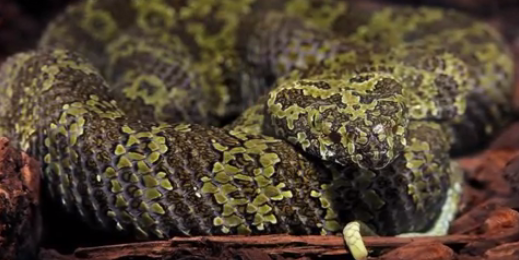Authorities Say Habitat Loss is the Biggest Threat to China's Wildlife
| Mia Ren | | Jan 31, 2016 07:23 AM EST |
(Photo : YouTube) The Mangshan pit viper is one of the species of animals that the study found has experienced a reduction in population due to the loss of habitat.
Loss of habitat is the biggest cause of the dwindling numbers of China's wildlife, topping disturbances from major construction projects near nature reserves and direct human interference.
A research by the State Forestry Administration (SFA) revealed that out of the 14 wildlife animals under study, the population of two species decreased. The Forestry Administration enlisted the help of more than 270 people from 80 research institutes, nature reserves, and colleges in the country for this study.
Like Us on Facebook
The research was concluded at the end of 2014.
"Our analysis shows that 34.69 percent of species have been threatened by all kinds of habitat loss, including disturbances, destruction, segmentation and degradation. It's a threat more serious than other threats," said Yan Xun, chief engineer of SFA's wildlife conservation.
At a press conference last week Thursday, the SFA said that the Central Asian tortoise and the Mangshan pit viper had significantly decreased in number compared to the first survey launched in 1995.
Populations of the rufous-backed bunting, Chinese alligator, qinling pit viper, plateau pit viper, and Chinese pit viper were stable. Meanwhile, numbers of the Hainan black-crested gibbon, crested ibis, black grouse, Chinese crocodile lizard, Black-faced spoonbill, and the relict and Saunders' gull increased.
The Crested ibis, a water bird that can only be found in China, rose from only 147 in 1995 to 1,549 in the survey. Black-faced spoonbills increased from nine to 28, and its wintering population grew from 120 birds to 294.
TagsHabitat loss in China, China's wildlife conservation, State Forestry Administration
©2015 Chinatopix All rights reserved. Do not reproduce without permission
EDITOR'S PICKS
-

Did the Trump administration just announce plans for a trade war with ‘hostile’ China and Russia?
-

US Senate passes Taiwan travel bill slammed by China
-

As Yan Sihong’s family grieves, here are other Chinese students who went missing abroad. Some have never been found
-

Beijing blasts Western critics who ‘smear China’ with the term sharp power
-

China Envoy Seeks to Defuse Tensions With U.S. as a Trade War Brews
-

Singapore's Deputy PM Provides Bitcoin Vote of Confidence Amid China's Blanket Bans
-

China warns investors over risks in overseas virtual currency trading
-

Chinese government most trustworthy: survey
-

Kashima Antlers On Course For Back-To-Back Titles
MOST POPULAR
LATEST NEWS
Zhou Yongkang: China's Former Security Chief Sentenced to Life in Prison

China's former Chief of the Ministry of Public Security, Zhou Yongkang, has been given a life sentence after he was found guilty of abusing his office, bribery and deliberately ... Full Article
TRENDING STORY

China Pork Prices Expected to Stabilize As The Supplies Recover

Elephone P9000 Smartphone is now on Sale on Amazon India

There's a Big Chance Cliffhangers Won't Still Be Resolved When Grey's Anatomy Season 13 Returns

Supreme Court Ruled on Samsung vs Apple Dispute for Patent Infringement

Microsoft Surface Pro 5 Rumors and Release Date: What is the Latest?










